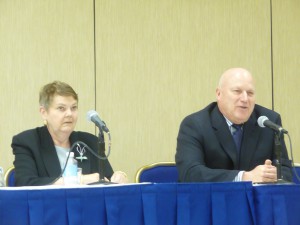
Dr. Larissa Grunig and her husband, Dr. James Grunig, lectured about the importance of measuring the relationship in PR at the Third Annual Grunig Lecture.
“Grunig” is a name I saw in textbooks when I took my PR prerequisite courses. The name is legend, synonymous with PR research, excellence and theory.
So when I saw that PRSA hosted an annual “Grunig Lecture” (let alone that the series is in its third year!), I positioned my time to attend the session.
Like a well-balanced communications team, Drs. Jim and Lauri Grunig taught us attendees about the importance of relationships in PR — not only through their research, but also through their example.
“Relationships are what make public relations excellent,” Jim Grunig told us.
Maybe that’s how the Grunigs, together, have been a PR research powerhouse through the years, managing to author more than 60 books and form theories when there weren’t any. They showed us that their relationship made them excellent. It’s called synergy.
The Grunigs did concede that, traditionally, the problem with PR and relationships hasn’t been that we neglected building them with our publics, but that we just didn’t know how to measure them. Until recently.
“We’ve identified qualities that can be measured in relationships, from spouses [I thought I saw Lari Grunig look over at her husband as she said this!] to organization’s critical publics,” she said.
This really resonated with me because I chose PR as an undergraduate degree not only because we focus on making money for organizations (like the Business Case for Public Relations reminds us), but we also focus on making meaning too. And that meaning is built and provides value through relationships of trust.
“Not only is public relations all about relationships, but that is what life is all about,” Lari added.
My takeaways from the legendary lecture
These are the six qualities that the Grunigs and their colleague, Dr. Linda Childers Hon, discovered in quantifying relationships — whether in an organization and its publics, or a just personal friendship.
- Trust: You must feel comfortable making yourself vulnerable in the relationship. You have to give up some control.
- Satisfaction: What you put in equals what you get out — you’re not always giving.
- Commitment: Especially in times of crisis, both parties are in it for the long haul. It’s loyalty.
- Control mutuality: Both parties have a say in the relationship. One side isn’t walking all over the other.
- Exchange: If the relationship is built on “this for that,” it’s an exchange relationship.
- Communal: If the relationship is built on “what’s more important for the relationship and not for your self-interest,” it’s a communal relationship. This is what ethical PR practitioners strive for and what social media is making easier.
“A boyfriend who always picks out the movies to watch isn’t a communal relationship,” Lauri said. “Who wants to marry a bully?” I wouldn’t want to advocate as a bully either. And thanks to the Grunigs and Dr. Hon … I don’t have to.
Philip Volmar, 2010 summer intern, publications, PRSA’s Tactics and The Strategist. He is a senior majoring in public relations at Brigham Young University, with minors in editing and business management. Connect with Philip on LinkedIn and follow him on Twitter at @pvolmar.
For more coverage on the PRSA 2010 International Conference: Powering PRogress, visit PRSA Intelligence, follow #prsa_ic and the Conference blog.






